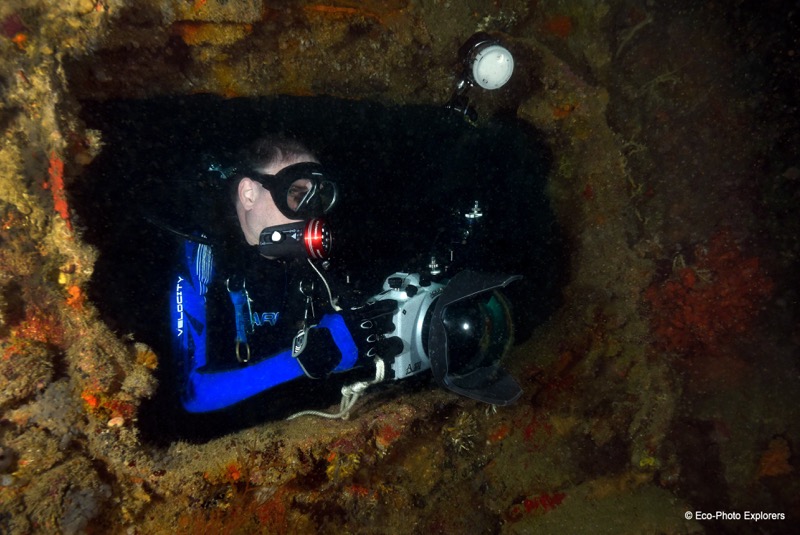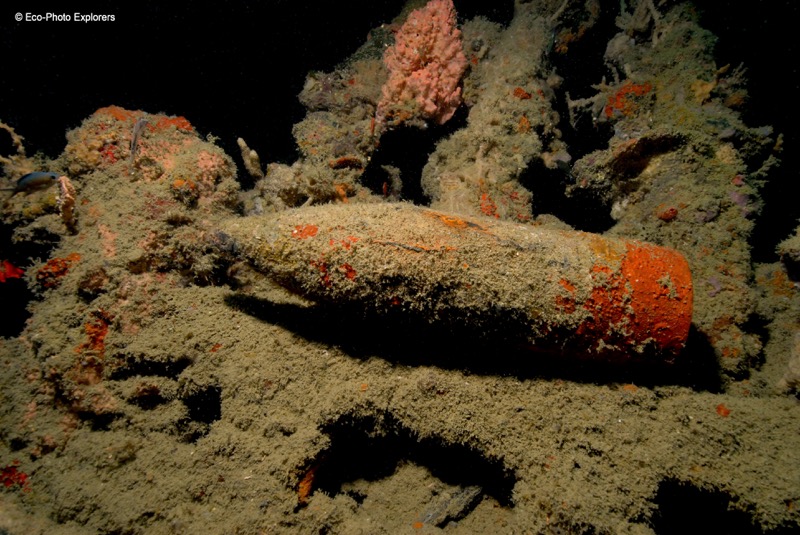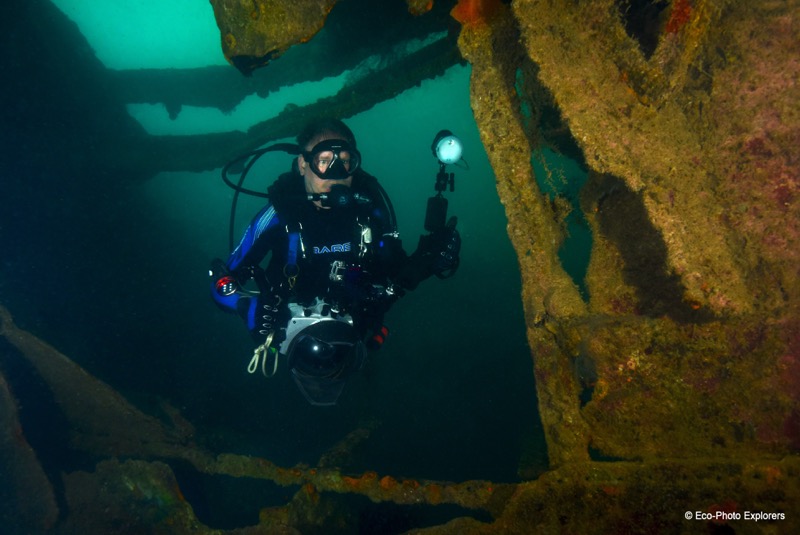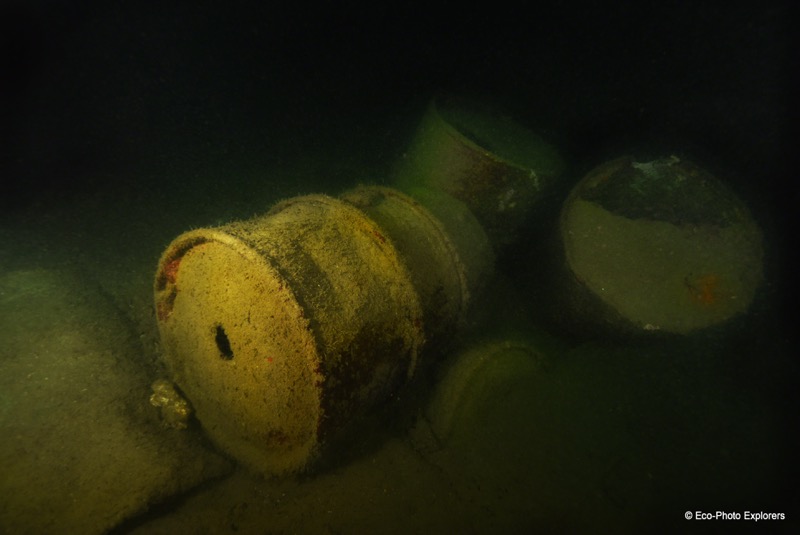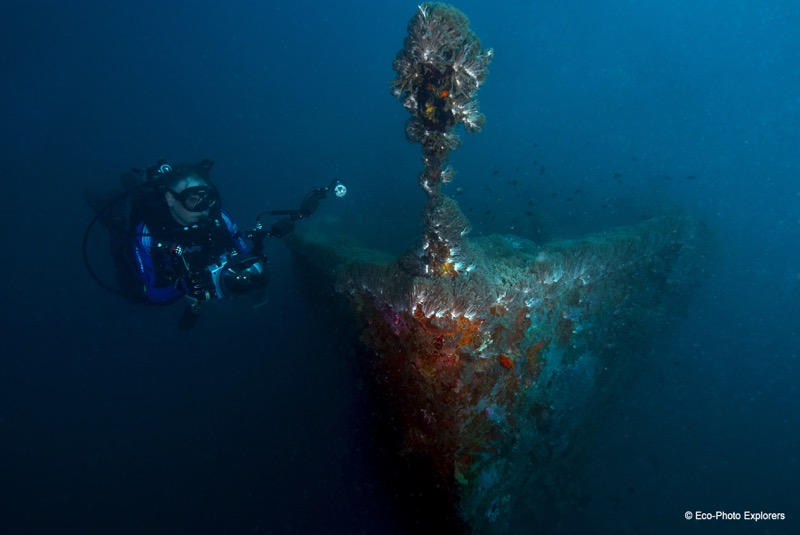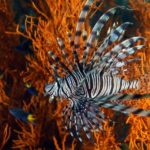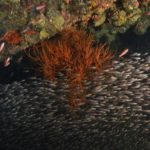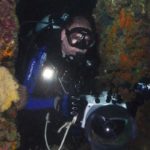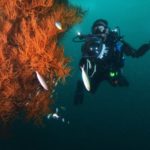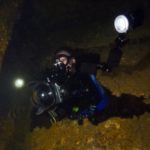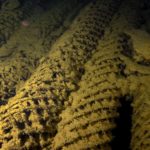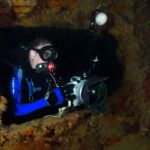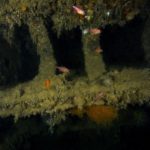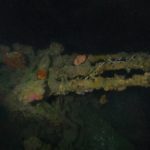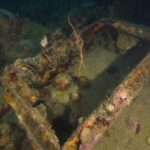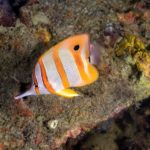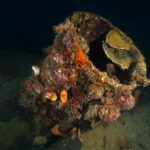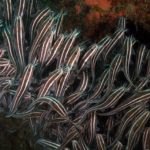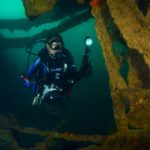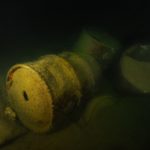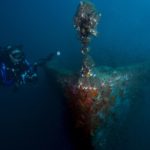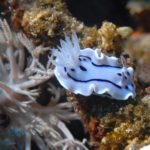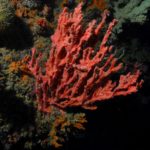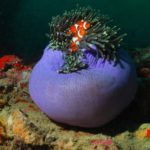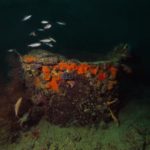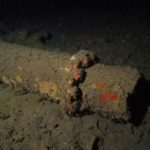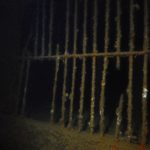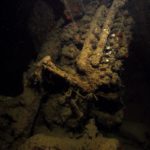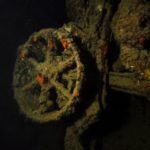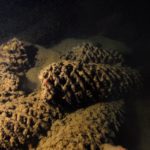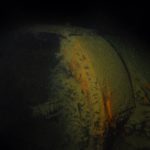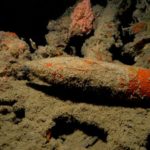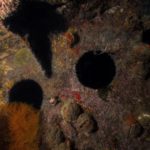The down line disappeared into the murky waters of Coron Bay in the Philippines and with 25 foot visibility we simply had to trust that eventually it would lead us to our objective. Slowly, hand over hand we descended into the warm waters of the bay until our eyes finally began to discern the faint outline of the hulk of a sunken ship. At first hazy and almost imperceptible, with every foot of additional depth the ship came into sharper focus. We were diving on the wreckage of the Akitsushima, a Japanese Seaplane Tender resting on her side in 118 FSW (36 meters).
Story and photos by Michael Salvarezza and Christopher P. Weaver
Our descent took us to a spot near the stern where we began our exploration of one of the vessels lost in the United States Navy attack on a fleet of Japanese warships on September 24, 1944. Our eyes quickly adjusted to the light in the hazy water and we immediately recognized the remains of the ship’s crane lying in the sand. The crane was used to lift seaplanes from the water onto the deck; today, it is home to schools of fish seeking shelter from predators. Resting alongside the crane is a 3-barreled anti-aircraft gun and projectile, appearing as if they were poised to resume the battle that sent them to their watery resting place all those years ago. We were only a few minutes into our dive and we were already enthralled.
The Akitsushima was hit near the stern and an opening into the bowels of the wreck, evidence of the damage that caused her to sink within a few minutes of being hit, invited us inside. Leaving the sunlit world of Coron Bay, we entered the dark, ghostly confines of the sunken ship to touch history and witness the wreck as she reposes today. Our mix of 28% Nitrox helped ward off the effects of narcosis as we pushed deeper into the mangled insides of the wreck, but the ship’s disorienting position on the bottom and the impressive internal damage from the attack presents unique challenges to navigating these internal passageways.
We quickly navigated through hazardous wreckage, narrow corridors and cargo holds before emerging near an opening close to the bow. Rising to the top of the wreck, we slowly rode the slight tidal current back to the up line where we began our ascent. Later, as our faces broke the surface, greeted by the warm, mid-morning Philippines sun, we smiled broadly to each other…our exploration of the shipwrecks of Coron Bay was on!
In the Second World War, the Philippines archipelago was the site of several fierce battles between American and Japanese forces. During the Battle of the Philippines in 1941 and 1942, Japan invaded Luzon from the north and attacked Manila from the land. American and Filipino troops, led by Gen. Douglas MacArthur, retreated to the Bataan Peninsula. The fall of Bataan, on April 9, 1942, signaled the victory of Japan in Manila and the northern Philippines. The Bataan Death March is an indelible icon of the brutality of this period of the war.
As the American forces battled to liberate the Philippines, the Battle of the Philippine Sea took place between June 19th and 20th, 1944 and was followed by the Battle of Leyte Gulf in October 1944. In between these two battles, the US Navy launched a strike force of fighters and bombers to attack a Japanese supply fleet of up to 24 ships that were at anchor in Coron Bay and around the nearby Busuanga Island on September 24, 1944. This was a surprise aerial attack by the US Third Fleet, under the command of Admiral William F. “Bull” Halsey aboard the battleship USS New Jersey. Vice Admiral Marc A. Mitscher, who was in command of Task Force 38 from the aircraft carrier USS Lexington, provided tactical control of the attack.
A total of 96 Grumman F6F Hellcat fighter escorts and 24 Curtiss SB2C Helldiver dive-bombers took off from their positions 340 miles away on the morning of September 24th, 1944 and ultimately surprised the Japanese fleet at Coron. In a devastating aerial assault, the US Navy sent these ships to the bottom of Coron Bay. Today, many of these shipwrecks are accessible to SCUBA divers who wish to explore history and witness the tragedy of war first-hand.
The Olympia Maru was a Japanese Freighter that is now sitting upright in 98 FSW (30 meters). Descending into the cargo holds of the Olympia Maru, divers come across piles of large barrel drums covered in silt and strewn across the bottom of the holds. Swimming through these silent passageways, one can imagine the chaos of the sinking of the ship that caused these drums to be so violently tossed about. Outside the shipwreck, huge schools of silversides glide over the wreckage and divers will often encounter schools of batfish swimming in and around the wreck. Resting in disguise on the deck are venomous stonefish, so divers should be careful about touching anything on this wreck.
The Kogyo Maru lies on her starboard side in 112 FSW (34 meters) and offers divers swim throughs into all six of her cargo holds and into the engine room and bridge area. In the second cargo hold, a small bulldozer is readily apparent, along with a pile of cement bags that tumbled chaotically as the ship sank. The Kogyo is also home to brilliant soft corals that adorn the top of the wreck at 72 feet (22 meters). It would be easy to lose focus on the wreck itself as you swim alongside clouds of small reef fish, and observe predatory lionfish lying in wait amongst the wreckage and corals.
At 8:55 in the morning of September 24, 1944, dive-bombers from the US Navy forces attacked the Okikawa Maru. The first two groups simply strafed the vessel, a Japanese tanker. These groups then headed for the Akitsushima Maru, anchored nearby. But a few moments later, at 9:10am, dive-bombers scored numerous direct hits on the ship and she began to sink. Official records are unclear, but it has been reported that three gunners and five or six sailors were killed in the attack. Interestingly, the Okikawa Maru initially did not sink completely. The forecastle remained afloat, burning until the 9th of October when another US Air group sent her to the bottom in a final attack.
Today, the Okikawa Maru lies upright in 85 FSW (26 meters) with its main deck reachable between 32-52 FSW (10-16 meters). The bow section is crumbled and pointing upwards from the main wreckage. Perhaps the most interesting wreck in Coron, the Okikawa Maru offers both a plethora of colorful marine life and fascinating opportunities for wreck penetration and exploration. Inside the wreck, divers can traverse the propeller shaft from outside the ship all the way to the engine room. Divers can also explore the ship’s prison and, examining the rusting bars of the jail cell, imagine what life was like aboard these vessels during the war.
There are other shipwrecks in and around the Coron Bay area inviting wreck divers to explore their broken bones and shattered keels. The Teru Kaze Maru is a gunboat or submarine hunter that lies in very shallow water on the east side of Tangat Island. Starting in only 10 feet of water (3 meters) and dropping to 72 FSW (22 meters), the wreck is available for snorkelers as well as divers.
For divers with deep diving experience, the Irako, a Japanese refrigeration ship that lies in 141 FSW (43 meters) at the mouth of Coron Bay often boasts the best visibility of the Coron wrecks and is one of the most picturesque shipwrecks in the area.
There are several other wrecks whose identity is still unknown. These ships add to the mystery of the place…what were they, what is their story and how did they eventually sink?
The waters of Coron Bay are relatively protected but the passages between the islands are subject to swift currents during tidal exchanges. Dives on the wrecks should be planned in accordance with these currents. In addition, it is often a surprise to divers first visiting the Coron area to find waters that are somewhat murky and silty. Visibility can exceed 100 feet on good days and drop to only a few feet on bad days. Average visibility on the wrecks is generally between 20-30 feet (6-9 meters). To experience these wrecks safely and comfortably, divers should have advanced open water certification and, before penetrating any of these wrecks, make sure they have wreck diver certification and the proper experience.
Diving the Coron Bay shipwrecks is a journey back through time. For divers lucky enough to explore these monuments to the battles that convulsed the entire planet during the Second World War, it is an opportunity to connect with the stories, tragedies, heroics and bravery that unfolded each day of the war.
As we concluded our expedition to the wrecks of Coron Bay, we sat on the deck of the Big Beth, the liveaboard vessel operated by the Marco Vincent Dive Resort in Puerto Galera that we used for this trip, and marveled at the canopy of brilliant stars that draped the sky from one horizon to the other. We were at sea, far away from Coron and headed to Apo Reef. Without the interference of any light sources, the stars appeared numerous and brilliant. And they seemed to extend right into the water, where flashes of bioluminescent light mimicked the starlight and created a continuum of pinprick lights dancing in the waves and the sky. This mesmerizing and enveloping cathedral of lights reminded us of how we are all connected in this world…to each other, to our past and to our future. The history that lies beneath the waves in Coron Bay is a part of the tapestry of the human experience. It is one to be explored, preserved and revered until the day the sea finally consumes these wrecks and returns them to the sands of time.
Getting There
The gateway city into the Philippines is Manila. Flights arrive from numerous locations around the world, with many convenient connections available through Hong Kong, Seoul, Japan and other cities in Asia. From Manila, various travel options, including domestic flights and ferry services, are available to other provinces in the country. There are flights from Manila to Coron.
The Marco Vincent Dive resort is located in Puerto Galera and provides multi-day safari style liveaboard dive trips to Coron on their dive vessel Big Beth. Contact them at http://marcovincent.com
For US visitors, a VISA is not required. If you are a citizen of another country, check the VISA requirements before planning your trip.
A valid passport is required for entry, and must be valid for 6 months after arrival.
Immunizations and Medicine
As with any travel to tropical regions, make sure all your vaccinations are up to date! All travelers should visit their personal physician or a travel health clinic to discuss what vaccinations (e.g., Hepatitis A, Hepatitis B, Malaria, Typhoid, or Tetanus-diphtheria) and travel medicine are recommended. All medicine should be packed in their original, clearly labeled containers. Having a signed and dated letter from a physician describing your medical conditions and medications is suggested.
Note: Travel health clinics usually provide more detailed health protection measures since they specialize in travel medicine. Beware of travelers’ diarrhea, which is the most common travel-related ailment. Insect protection is a must and essential!
Baggage
Baggage allowances vary for each international carrier so check before you leave.
Weather
The Philippines has a tropical climate. There are basically two seasons: the wet season (May-October) and the dry season (November-April). April and May are the two warmest months, marked by high temperatures and humidity. During these months, temperatures can reach 90 degrees F or higher. In the cooler months of December and January, temperatures moderate with less humidity.
The Philippines is in the tropical cyclone belt, and typhoons threaten the region between July and October. Typhoon Yolanda struck the southern regions on November 8, 2013, with devastating results. The damage and affects were limited to the south, however, and Puerto Galera and Verde Island were not affected in any way.
Currency
The local currency is the Philipino Peso but US Dollars are often accepted at all resorts.
Electricity
Power voltage used in the Philippines is 220 Volts (50 Hz). Be sure to double-check your appliance’s compatibility before plugging them in. Converters / adaptors are usually available upon request at your hotel front desk.
——————————————————————————–
Story and photos by Michael Salvarezza and Christopher P. Weaver
- A Lionfish photographed on the Olympia Maru
- Schools of shimmering baitfish explode from the interior of a wreck
- Sometimes the most fascinating marine life just drifts by.
- The Okikawa is a lush garden of marine life
- A school of fish escaping the interior of the Okikawa
- Author Christopher Weaver on the Okikawa wreck
- The entrance to the Okikawa prison
- Photographing marine life on the sides of the Okikawa wreck
- Author Christopher Weaver explores the interior of the Kaogyu Maru
- Cargo inside the Kaogyu Maru
- Author Christopher Weaver explores the wreck of the Akitsushima
- Deep inside the wreck of the Akitsushima
- The remains of an anti-aircraft gun on the Akitsushima
- The deck of the Tere Kaze Maru
- A Long Beaked Coralfish (Chelmon rostratus) on the Tere Kaze Maru
- The wreck of the Tere Kaze Maru has become a living reef
- The wreckage of the Tere Kaze Maru
- A school of catfish seeks shelter alongside the wreckage of the Olympia Maru
- Author Christopher Weaver explores the shadowy remains of the Olympia Maru
- Barrels from inside the Olympia Maru
- Author Christopher Weaver explores the ghostly bow of a small wreck in a harbor near Coron Bay
- A Willan’s Chromodoris (Chromodoris willani) photographed on one of the wrecks
- Clouds of baitfish can be found outside the Okikawa wreck
- The Okikawa wreck is a colorful mélange of marine life
- The wrecks of Coron have become overgrown with marine life
- The wrecks of Coron are home to a beautiful array of indo-pacific marine creatures
- The Okikawa offers a glimpse into the history of the wrecks of Coron Bay
- Wreckage inside the Okikawa
- Author Michael Salvarezza explores the Okikawa prison
- Inside the Okikawa divers can swim into the former onboard prison
- A pair of anemonefish make their home on the deck of an old freighter ship
- The remains of an old bulldozer inside the Kaogyu Maru
- Inside the Kaogyu Maru is an old bulldozer
- The Kaogyu Maru cargo
- The ghostly wreckage of the Kaogyu Maru
- The wrecks of Coron Bay are home to fascinating marine life, like this Crocodile Fish
- An artillery shell on the Akitsushima
- The Tere Kaze Maru lies in shallow water with often limited visibility

